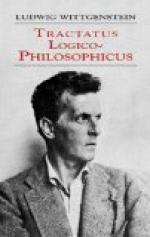4.463 The truth-conditions of a proposition determine the range that it leaves open to the facts. (A proposition, a picture, or a model is, in the negative sense, like a solid body that restricts the freedom of movement of others, and in the positive sense, like a space bounded by solid substance in which there is room for a body.) A tautology leaves open to reality the whole—the infinite whole—of logical space: a contradiction fills the whole of logical space leaving no point of it for reality. Thus neither of them can determine reality in any way.
4.464 A tautology’s truth is certain, a proposition’s possible, a contradiction’s impossible. (Certain, possible, impossible: here we have the first indication of the scale that we need in the theory of probability.)
4.465 The logical product of a tautology and a proposition says the same thing as the proposition. This product, therefore, is identical with the proposition. For it is impossible to alter what is essential to a symbol without altering its sense.
4.466 What corresponds to a determinate logical combination of signs is a determinate logical combination of their meanings. It is only to the uncombined signs that absolutely any combination corresponds. In other words, propositions that are true for every situation cannot be combinations of signs at all, since, if they were, only determinate combinations of objects could correspond to them. (And what is not a logical combination has no combination of objects corresponding to it.) Tautology and contradiction are the limiting cases—indeed the disintegration—of the combination of signs.
4.4661 Admittedly the signs are still combined with one another even in tautologies and contradictions—i.e. they stand in certain relations to one another: but these relations have no meaning, they are not essential to the symbol .
4.5 It now seems possible to give the most general propositional form: that is, to give a description of the propositions of any sign-language whatsoever in such a way that every possible sense can be expressed by a symbol satisfying the description, and every symbol satisfying the description can express a sense, provided that the meanings of the names are suitably chosen. It is clear that only what is essential to the most general propositional form may be included in its description—for otherwise it would not be the most general form. The existence of a general propositional form is proved by the fact that there cannot be a proposition whose form could not have been foreseen (i.e. constructed). The general form of a proposition is: This is how things stand.
4.51 Suppose that I am given all elementary propositions: then I can simply ask what propositions I can construct out of them. And there I have all propositions, and that fixes their limits.
4.52 Propositions comprise all that follows from the totality of all elementary propositions (and, of course, from its being the totality of them all ). (Thus, in a certain sense, it could be said that all propositions were generalizations of elementary propositions.)




